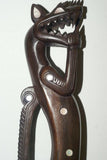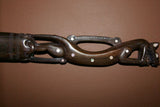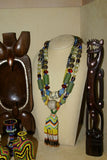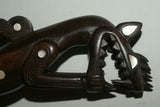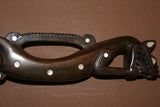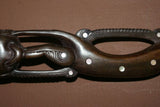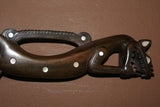Oceanic Art Detailed Lacy Dragon Ebony Totem Twirled Amulet Chief Art Staff 1A34
Item 1A34 in our inventory
Measures: 14.5"X 2.5"X 1.5"
This totem effigy statue is smooth and magnificent in work and symbolism as it is a chief's staff
(photos of slim dark precious wood figures are very hard to take because of difficulty of focus, the darkness of the subject etc... I apologize if the item is not seen clearly enough)
Totem staff is much nicer in reality
This was the staff of a tribal chief (from the Massim region)
(Seen on photo 1 and following ones)
A sign of power and riches in the remote Trobriand Islands.
Melanesia Massim Kula Trobriand hand carved rosewood Tall Totem Effigy
Hand-carved with extreme minute detail with many enhancing inlaid mother of pearl motifs.
This Figural Totem was part of our private collection and is seen on all the pictures here.
Some motifs intertwined within each other, mythical meanings often appear in the sculptor's dream and work.... Such a statuette is very detailed and hard to carve in dense wood. This is spectacular in detail and mastery and was collected years ago.
The piece was carved for the Kula trade, a means of exchange or gift between islands on the sea-going-canoe route, it was just an important exchange item between different islands laid in the chief’s hut as a valuable or handled during festivities.
This is a beautiful completely hand carved hand crafted Melanesian (remote Massim region) Statue Effigy
(seen on photo 1 to 12)
From the isolated Massim trade route and region, Trobriand Islands north of Papua New Guinea
Beautifully carved by a local master carver with rudimentary tools
Amazingly perfect considering the basic tools used such as pieces of broken shells, rusted nails from shipwrecks found on the beaches, and sea ray, shark skin or an animal horn or tusk rubbed for days against the surface till all is smooth, among other sanding materials, and to produce a sheen on the wood.
The pieces are different sizes (the tallest one 12 1/2" and a ruler has been placed next to them so you can see how tall they are). It is very hard to come across such scarce collectables unless you go there
These beautiful art pieces are rare items of the Kula ring. We collected them while in the remote Trobriand chain of islands, which are north of Papua New Guinea.
We collected many beautiful pieces while in the Trobriands from carvings (created out of kwila, rosewood and ebony) to costumes, drums and Kula ring exchange items that we will list whenever we have time.
In these islands which are rarely visited, outside influence is at a minimum. The extremely skilled carvers inspire themselves from what is around them as they have access to nothing else: the natives, birds, fish, pigs, marine turtles, snakes and whatever they see in their dreams such as dragons or mystical figures.
Some of these items have very important meanings as they are used as part of the Kula ring trade system that has existed between the islands for centuries.
The Kula ring is a system of exchange involving annual inter-island visits between trading partners who exchange highly valued shell ornaments and other things during year long sea travels.
This trade ranged from a surplus of pigs and yams in the Trobriands to the fine art or pottery found in the Amphletts. Other places became known for obsidian and Betel nut. It is believed that this myth could be one of the origins of the and the way it functions. Kula is a ritualized trading culture existing in eastern which the Trobriands are part of. It is essentially network of villages joined by a common trade route, known as the . By analogy, Kula allows you to experience the magic and legends of . Kula was and still is a life sustaining cultural exchange. It is unfortunate that much of the time and energy that was used in the past to hold together the social foundation is now being clouded with the desire for money, a by-product of a tourism-based economy. With influences such as these and the advancement of technology, the intricate pattern in which traditional values are based is slowly eroding.
Kula is the basis of mental and physical well-being. The trade has always been associated with making contact with far off neighbors. Traditionally two kinds of items were traded; arm bands carved from the sea shell known as Mwali and spondylus shell necklaces, Soulava. Each of these items was traded individually, but other items were given as gifts too such as carvings and valuables. Mwali and Soulava traveled in opposite directions around the (group of islands). Mwali passed anticlockwise in the ring and were given with the right hand, the Soulava passed clockwise and was offered with the left hand, first between villages then from island to island.
Such pieces are used by the indigenous people of the most primitive areas of Papua New Guinea. These proud people have managed, in the face of continued government and missionary pressure, to maintain a culture of incredible depth and beauty. For the most part, they still live by the same methods as have existed in their remote land for thousands of years.
All our collector and rare items come with pages and pages of research about provenance, and with history of the tribes and photos as well, depending on item and whenever possible. When shipping internationally, we group ship multiple purchases to save you money, and find the best rates available. If you have any questions or want to see research conducted on this piece and photos of tribes, tell us.
We have artifacts and architectural accents up to 10 ft tall that we will put on upon request because shipping has to be calculated accordingly with trucking company.












